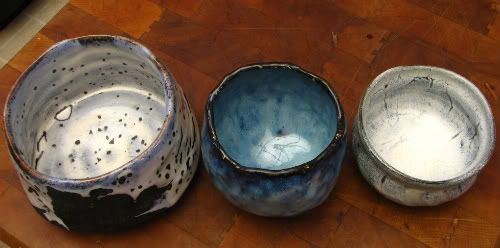It's still very subjective of course, but I tried to line up several chawan for comparison to the size of the average Western Style teacup. It was the only tea-related thing I knew would be fairly standardized, and could serve as a visual comparison.
Dimensions are included, as well as my thoughts on size, weight and balance. For reference, I have small to average size hands for a woman, off the shelf OS gloves fit me easily with a little room to spare. Physically, I'm extremely strong and muscular, so that might skew my opinion of chawan heft. Each image below is clickable to open larger. Each image has dimensions and weight of the objects below.

Teacup is for reference, and is (obviously) the same in each image, it's a standard size English Style Teacup (Homer Laughlin Skytone for you Teacup fans.
red by cory lum: 11.9oz 4.25"w x 3"h
celadon by cory lum: 23.9oz 5.375"w x 3.5"h
The red chawan is nearly a perfect size for me for everyday. It's heavy enough to feel comforting, and perfectly balanced, but still comparatively lightweight considering the density of the clay. In larger hands, this bowl would probably feel quite small.
The celadon chawan, though beautiful and excellently balanced, weighs just shy of 1.5lbs. It is truly too much bowl for me. For me, the fine line in chawan size seems to have more to do with the weight of the bowl, than the actual dimensions. I have two other bowls in my collection that are nearly the same dimensions as this, but weigh about 8oz less. They feel comfortable to me.
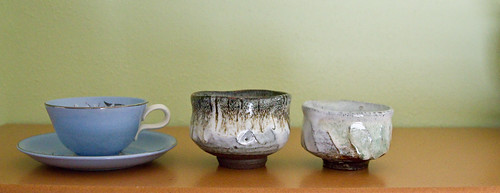
Cuke travel chawan: 8oz, 4"w x 2.75"h
sansai wan: 6oz, 3.5"w x 2.375"h
The sea cucumber hagi travel chawan is about as small as is practical to get a whisk into. I know there are people on forum who will prepare matcha in even smaller bowls, and I have done it myself, but I wouldn't recommend smaller. This bowl is nicely weighted and feels like holding a very large egg. It nestles in nicely.
The Sansai hagi wan next to it is an example of what I consider to be clearly too small for matcha, although I think you'll see a couple of images on board where people have used it for such. Still, it's surprising what a difference that 1/2" is, practically speaking.
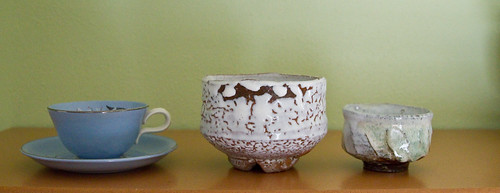
Large Deishi: 15.3oz 5.125"w x 3.5"h
sansai as above
This large Deishi hagi chawan is one of my favorite pieces in my collection, I tend to save it "for special." heh. You can see the dimensions are almost the same as the Celadon above, but over 8oz less in weight. Many hagiware are made of a rough sand clay that is amazingly lightweight, and changes the size/balance equation. For me, this chawan, in spite of its larger dimensions, is still very comfortable to use, even with small hands.
Sansai wan again, so you can get a feel for the tremendous size difference.

kyoyaki hira: 6oz, 5.375"w x 2"h
kyoyaki Gold Crane: 8.7oz, 4.75"w x 3"h
I mentioned before that you might want to look at some of the kyoyaki (also sometimes called Kyoto or Ninsei or handpainted- there seems to be little standardization on terminology that makes sense to this Westerner.) THIS store on ebay often has these type chawan, as well as the previously mentioned Rikyucha.
As you can see, both of these bowls are extremely lightweight. The hira (summer style) chawan, being more open, can be a trick to whisk in, but its lightweight and airy feel make it worth the effort. This is a very tiny bowl, in terms of weight. It weighs slightly more than 1/2 that of the teacup and saucer. It is as light as the tiny sansai wan.
The gold crane chawan is a perfect balance of size and light weight. It's just a few ounces more, but has the higher straighter sides that make whisking such an easy task.
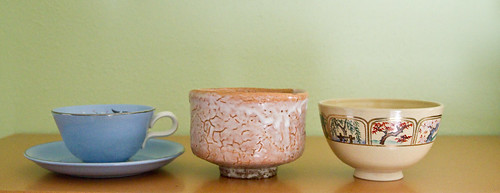
loquat: 12.1oz, 4.5"w x 3"h
kyoyaki seasons bowl: 6.5oz 4.75"w x 2.75"h
The kyo seasons bowl is nearly the same dimension as the gold crane, but lighter. This bowl is about 50 years old and very thin. It was also very inexpensive. Bowls like this can be found for $10-20 on ebay if you watch for them. They were very common, and although quite delicate, show up in excellent condition with some frequency at the various Japanese ebay auctioneers.
The loquat hagi is another example of a larger bowl being very light. The clay is not dense, thus weighs considerably less than many comparably-sized non-hagi bowls.
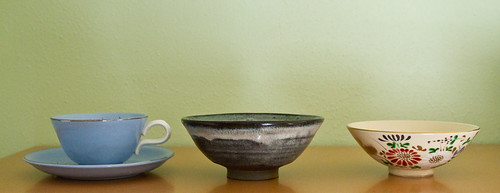
green/grey 9.6oz, 5.75"w x 2.5"h
kyoyaki chrysanthemum hira as above
The green/grey chawan (I wish I could remember what style/glaze this is,) the first "real" chawan I purchased. After that, I no longer tried to make do with bowls that seemed to be "kind of like a chawan." You can see the size is slightly larger than the hira chawan, being a scant 1/2" larger in both dimensions. This is a very comfortable open-style bowl, and one I use frequently. In small hands it is a perfect fit, but the form is so precise, I'm sure someone of larger stature would feel comfortable using it also.
Hope that helps.

